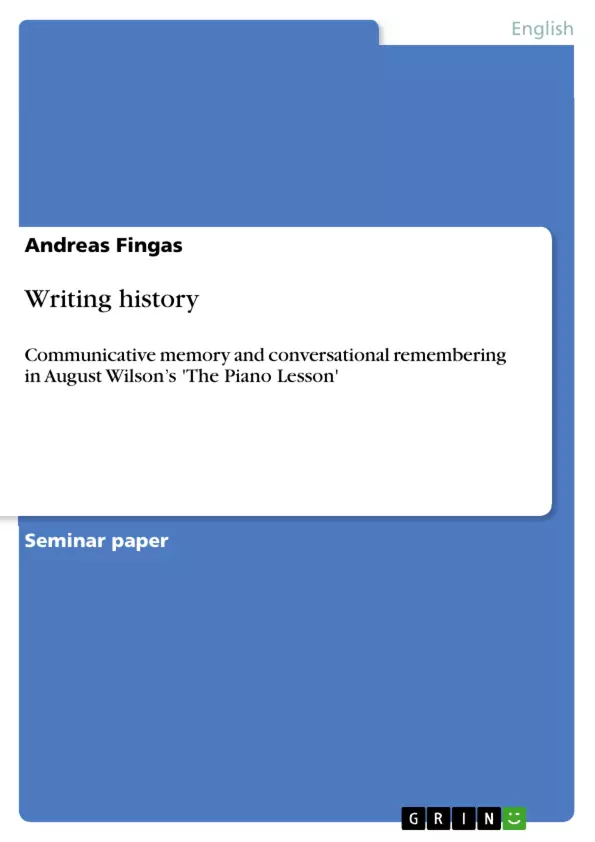History is an issue of great meaning within the works of August Wilson. In this paper shall be analysed through which channels and with which methods the author
transports not only the history of a family, but also the history of slavery interwoven with the experiences of the characters and their ancestors in the award winning novel The Piano Lesson. In this process of analysis we will find, that Wilson proposes a concept of memory that can be summed up with the term “kommunikatives Gedächtnis” which was coined by Jan and Aleida Assmann and further developed by Harald Welzer. For better understanding the term “communicative memory” will be used instead. In his play Wilson uses the method of storytelling. Through this we can see how the characters within the play communicate with each other and on one level transport communicative memory. But on the other level the reader becomes a silent listener participating in these conversations and in this role is able to read historical elements from the subtext of the stories told. In the last chapter August Wilson’s way of communicating memory will be compared to Toni Morrison’s approach in Site of Memory. What the reader finds in the first lines of the play is a short description of the setting.
This short text tells about the Charles’ house and the people who live in it. Most of the description however is concerned with the piano. “What time or period is the setting for The Piano Lesson? That was the first question asked by the late great Chinese actor and director Ying Roucheng after he read the play in 1991.” His confusion concerning the time in which the action of the play is set can be understood easily, because nothing in the secondary text informs the reader about the temporal conditions of the play. It is necessary to take a closer look at the primary text to find the hints Wilson gives to define the temporal situation. The most prominent of those hints can be found in Doaker’s story about the piano when he says, that his older brother Boy Charles “would have been fifty-seven if he had lived. He died in 1911 when he was thirty-one years old.” Subsequently the reader has to do the math. Knowing this, the play must take place in the year 1936 or 1937.
Inhaltsverzeichnis (Table of Contents)
- Introduction
- Time and place
- Communicative and cultural memory
- Communicative memory in The Piano Lesson
- Wining Boy and Cloetha
- Wining Boy and the ghosts of the yellow dog
- Crawley's death
- The History of the Charles family
- Site of memory
- Conclusion
Zielsetzung und Themenschwerpunkte (Objectives and Key Themes)
This paper analyzes the role of memory and history in August Wilson's play *The Piano Lesson*. The author explores how Wilson uses the characters' stories and conversations to convey a sense of collective and individual history. The paper examines Wilson's approach to communicative memory and its connection to cultural memory, particularly in relation to the themes of slavery and family legacy.- The role of communicative memory in shaping individual and collective identity
- The interplay between history, memory, and storytelling in *The Piano Lesson*
- August Wilson's concept of communicative memory in relation to Jan and Aleida Assmann and Harald Welzer's theories
- The significance of "conversational remembering" in creating a sense of shared history
- The influence of the past on the present, particularly in the context of slavery and family legacy
Zusammenfassung der Kapitel (Chapter Summaries)
- Introduction: The introduction sets the stage for the analysis by highlighting August Wilson's focus on history in his works. It introduces the concept of "communicative memory" and its relevance to *The Piano Lesson*. The paper proposes that Wilson utilizes storytelling as a means to convey historical elements through both character interactions and the reader's own interpretation.
- Time and Place: This section explores the play's setting and its ambiguous temporal framework. The reader is encouraged to actively engage with the text and piece together clues about the time period from the dialogue, particularly from Doaker's account of his brother's death. This approach emphasizes the importance of communicative memory in constructing an understanding of history.
- Communicative and Cultural Memory: The third chapter introduces the concepts of communicative memory and cultural memory, distinguishing them from individual memory. It examines how both types of memory contribute to a sense of societal identity and unity, while also acknowledging the complexities of how individuals remember and forget.
Schlüsselwörter (Keywords)
The primary themes and concepts explored in this paper include communicative memory, cultural memory, historical storytelling, family legacy, African American history, slavery, and *The Piano Lesson* by August Wilson. The analysis focuses on how these themes are interwoven through the characters' experiences, conversations, and their collective understanding of the past.- Arbeit zitieren
- Andreas Fingas (Autor:in), 2008, Writing history, München, GRIN Verlag, https://www.grin.com/document/113108



